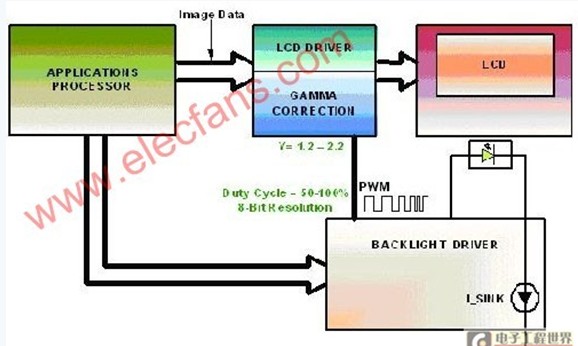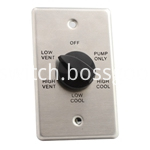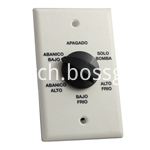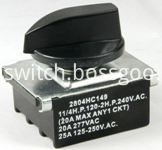At present, on portable consumer electronic devices, the larger LCD display used is backlit and requires intensive use of the processor, and the meaning behind it is to make the already limited battery capacity longer. And a larger current.
In the past, the monochrome display used two green LEDs in the backlight, which only consumed 10% of the total power consumption of the mobile device. Now, the larger and higher resolution color displays required for multimedia devices have increased power consumption in use and backlights by more than 50%.
Despite the latest advanced battery technology, the growth rate of battery capacity is still unable to keep up with the demand for additional energy in multimedia mobile devices. Because battery technology can't be improved at the same pace, portable device manufacturers face difficulties when trying to meet consumer expectations. Unless they can develop innovative ways to reduce power consumption or increase battery capacity, they must sacrifice battery life for those features.
In addition to technologies such as time based dimming, display timeout, and user-selectable brightness settings, many mobile device manufacturers use ambient lighting. Sensing (ALS), dynamic backlight control (cABC), and the use of a keypad/general input/output (GPIO) extender to help reduce current flow.
For most portable device manufacturers, display backlighting has become one of the most important battery current consumption priorities. Multimedia devices with high-resolution color displays require an appropriate backlight at all times to avoid degradation in visual performance and readability.
Although high-reflectivity displays always require a backlight and have relatively high power consumption, they are still favored by mobile device manufacturers. The indoor performance, NTSC gamut ratio, high contrast, and high brightness of this type of display have made it a winner in the same type of component. In order to reduce the power consumption of the backlight, it has become a necessary measure to control the intensity of the backlight as much as possible.
While the device can darken the backlight during periods of no action, thereby conserving power, many devices still have applications that require the backlight to remain on for a long period of time interacting with the user, such as web browsing, email, GPS. Navigation, games, or video playback.
The brightness control in the product settings menu allows the user to adjust the backlight intensity to save power in these use cases, but this requires user input and multiple changes to different ambient lighting conditions in order to be truly Play its usefulness. For users, these technologies are no longer of practical value and are not sufficient for the current intensive and unique use.
Ambient Lighting Sensing (ALS)
The demand for backlights for LCD or keypads may vary significantly as the lighting environment changes. With ambient lighting sensing, photodiodes or transistors can measure local illumination intensity. The source of light may be the sun, office lighting, or moonlight. The amount of light extracted by the sensor can be converted into current or voltage. Based on the preset threshold, the backlight driver or processor can determine how much backlighting the LCD or keypad requires.
Driving the high currents required in a sunny environment wastes the energy required in a dimly lit environment and can cause the eyes to fatigue in dim environments. Changing the backlight intensity depending on ambient lighting conditions can save more than 60% of the power required to drive backlight LEDs in a bright environment for typical usage conditions.
ALS implementation method
Some manufacturers use an analog or digital lighting sensor IC to sense ambient lighting. Analog lighting sensors convert light into electricity, while digital lighting sensors use an internal ADC to generate a digital bit stream. Analog lighting sensors are relatively inexpensive due to their simple implementation.
Regardless of which sensor is used, its output must be decoded before it can be used. There are many designs that use the main processor to decode the sensor output and control the backlight. However, the main processor must be fast enough to handle many multimedia features, so its higher speed and bandwidth also means that more current will flow out due to ALS detection. Minimizing processor intervention is important to reduce battery drain.
Some ICs such as ADI's ADP 5501 and ADP 5520 incorporate light input decoding and backlight driver control. There are several advantages to intelligently integrating the illumination detector into the backlight driver. First, the drive uses a simple state machine to perform its job, reducing the current consumption for decoding and backlight control to less than 20μA. Second, all features are in a single packaged chip, so the number of links and traces in the PCB layout can be minimized. Third, round-trip communication between the backlight driver and the primary processor can be minimized.
In order to give handset manufacturers flexibility, these integrated components have programmable thresholds, hysteresis, and filter times. Because all the mechanisms are designed differently, smart drives that are flexible enough to handle all conditions are quite important. Programmable thresholds allow handset manufacturers to program the range of light inputs (in daylight, office environments, or dim conditions). The hysteresis in each set of thresholds keeps the backlight from switching back and forth. The filter time allows the user to program how long the device needs to be exposed to the lighting environment before the backlight is adjusted. These types of adjustments make it more flexible for the corrections made by the handset manufacturer's products and products.
Analysis of display backlight
The display backlight uses six sets of 18 mA driven, serialized LEDs that draw 111 mA from the battery (assuming 3.5V LED forward voltage, 85% driver efficiency, and 4.0V battery). Therefore, if the drive is driven at maximum intensity during all operating hours, the display backlight itself can drain the 1100 mAh battery in 9.9 hours. The display does not need to be illuminated with maximum backlight intensity under all conditions, which can significantly save power in poorly lit environments such as offices, cinemas, and night outdoors.

Figure 1 Series backlight driver with integrated photoelectric sensor input, and mini keyboard/GPIO expander
The illuminance in sunny weather ranges from 32,000 to 100,000 lux (lumen), which is 100 times higher than the 400 lux in the bright office, so halving the backlight intensity when entering the room from the outdoors. It will not cause any loss to the usability and readability of the display. Most people spend an average of 60% of their time in the office, so a way to reduce backlight brightness like this can reduce current outflow by about 50% or more. In the previous example, the power consumption of the backlight will be reduced from 111 mA to 55.5 mA. When using ALS, the same display can last for 19.8 hours when using a 1100mAh battery.
Dynamic backlight control (Cabc)
Content Adaptive Backlight Control is a method of analyzing display content and adjusting the backlight of the display according to the grayscale content of the image and gamma correction technology. The display driver will output the PWM waveform to the backlight driver with different duty cycles based on the video grayscale content and gamma correction. The backlight will be attenuated for darker images. This reduces the power consumption of the backlight and enhances the contrast of the display while maintaining clear display quality. This method is especially useful when the scene will change from bright to dim in a prolonged period of time. cABC also reduces current flow for still images and standard menu screens.
User interfaces in mobile products can be specially crafted to take advantage of these saved power. cABC can reduce the power of the display by 20% to 50% depending on the image data. When combined with ALS, power savings can exceed 70%. IC manufacturers have begun designing power-saving ICs that combine the functions of both ALS and Cabc.

Figure 2 Dynamic Backlight Control (cABC)
Backlight of the keypad
In addition to the display backlight, ALS can also save power from the keypad backlight. Most pocket keyboards have a visible silkscreen that does not require a backlight in ambient lighting. A typical-sized keypad backlight based on LED or electroluminescent (EL) technology draws approximately 30 mA from the battery. If there is no ALS, the keypad must always be backlit, and this will waste a lot of energy. With ALS, the backlight driver can turn off or dim the backlight of the keypad, saving hundreds of mAh of current. A backlight driver with integrated ALS control provides an interrupt notification between light changes, allowing the processor to adjust on a keypad or other peripheral lighting.
For a group of devices capable of playing 7 hours of video on a 1100mAh battery, the 111mA display backlight current consumption represents 70% of the total current consumption in video mode. Halving the display backlight current consumption by ALS can increase the video playback time from 7 hours to 10.8 hours. Table 1 shows the power saved with ALS in different lighting environments. The display in the previous example, as well as the keypad backlight, draws a total of 141 mA in full-on conditions. In daylight, the keypad can be completely turned off, which will save 21% of the backlight current. The real savings in current consumption are in the office and in dimly lit environments. The display backlight current can be easily reduced by 50% without significantly degrading the display quality, in which case the backlight of the keypad can be completely turned off. With the ALS method, the current consumption of both backlights can be reduced by 61%. Keep the keypad backlight back on at maximum current in dim conditions, while reducing the display backlight to 24 mA for 62% current savings.
Kara offers a range of Rotary Switches.Ranging from 5 to 9 poles,15VA to 25 amp,with many choices of functions,especially the switches with High-Current .Certifications include CSA, CE, and more.
This item used very in the line of cooler,with metal panel or plastic panel or only switch are all available.



Rotary Switch,Rotary Switch Knobs,Rotary Switch 6 Position,Mini Rotary Switch
Ningbo Kara Electronic Co.,Ltd. , https://www.kara-switch.com